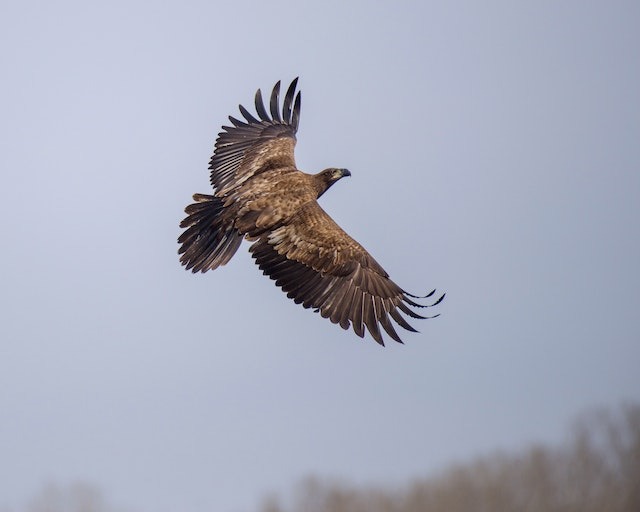How Do Eagles Sleep? Do they tuck themselves into tiny bird-sized beds with fluffy pillows? Or perhaps they drift off while perched on tree branches, balancing like tightrope walkers?
Eagles, those majestic birds with incredible hunting skills, have equally fascinating sleeping habits.
In this article, we’ll explore their unique sleeping patterns, revealing how they balance the need for rest with the instinct for survival.
From their adaptations to changing environments to the different stages of their sleep, get ready to uncover the secrets of eagle slumber. You won’t look at these mighty birds the same way again!
Table of Contents
- 1 Key Takeaways
- 2 How Do Eagles Sleep
- 3 The Unique Sleeping Habits of Eagles
- 4 Short Naps Throughout the Day and Night
- 5 Sleeping Posture
- 6 Adaptation to the Environment
- 7 Circadian Rhythm
- 8 Sleeping Patterns and Behavior
- 9 Impact of Environmental Changes
- 10 Research and Study
- 11 Sleeping Habits of Other Birds
- 12 Fascinating Facts about Eagles
- 13 Frequently Asked Questions
- 14 Conclusion
- 15 Author
Key Takeaways
- Eagles have unique sleeping patterns adapted to their environment and lifestyle, such as taking short naps throughout the day and night instead of long, uninterrupted sleep at night.
- Eagles can adjust their sleeping patterns according to the availability of food and have an internal clock known as the circadian rhythm that regulates their sleep patterns.
- Eagles have evolved mechanisms such as bilateral eye closure and unihemispheric sleep to help regulate their sleep and remain alert to potential dangers.
- Habitat destruction and climate change threaten eagle survival by affecting prey and nesting areas, altering eagle behavior, and reducing suitable nesting and foraging areas.

How Do Eagles Sleep
Eagles sleep by perching on high tree branches or rocky ledges. They use one leg to grip tightly while tucking the other leg up into their feathers.
They often sleep with their heads tucked back and their eyes closed. Eagles have a special tendon in their legs that allows them to lock their claws in place, ensuring a secure perch while they rest.
This sleeping posture helps protect them from falling and allows them to quickly take flight if needed.
The Unique Sleeping Habits of Eagles
The sleeping habits of eagles are distinct from other birds and are determined by their anatomy and behavior patterns.
These birds have a unique sleeping pattern, which includes short naps throughout the day and night, rather than a long, uninterrupted sleep at night like humans.
Eagles are known for their ability to sleep while standing, which is made possible by their strong talons and leg muscles.
They also have the ability to sleep while perched on a tree branch or on a rocky cliff, using their wings to maintain balance.
The duration and frequency of their sleep is influenced by their feeding habits and hunting patterns. Eagles are able to enter into REM sleep cycles, which is essential for their physical and mental well-being.
These cycles allow for restorative rest, which is necessary for their survival in the wild.
With this in mind, it is important to note that the sleeping habits of eagles are unique and complex, and are essential for their survival and overall health.
Short Naps Throughout the Day and Night
Throughout their waking hours, eagles take brief periods of rest both during the day and night, allowing them to conserve energy for hunting and other activities.
Eagles are known to take short naps throughout the day, which is also known as daytime napping.
These naps usually last only a few minutes at a time, and the eagles generally perch on a tree branch or a high perch during this time.
This allows them to keep an eye on their surroundings and be alert to any potential danger.
At night, eagles also take short rest periods, known as nocturnal rest. During this time, they may perch on a tree branch or roost in a nest.
Eagles have evolved this sleeping pattern as a way to conserve energy while still being prepared to hunt and defend themselves at any given moment.
This unique sleeping habit of eagles is one of the many fascinating aspects of their behavior. Moving forward into the subsequent section, we will explore the sleeping posture of eagles.
Sleeping Posture
Eagles’ sleeping posture is a crucial aspect of their behavior, as it allows them to conserve energy while remaining alert to potential threats.
Despite skeptics who may argue that eagles could simply sleep on the ground or in a more relaxed position, their upright posture enables them to quickly take flight if necessary, demonstrating the importance of maintaining this unique sleeping habit.
Eagles generally sleep while perched on a branch or other elevated surface, with their feet tightly gripping the perch and their body upright.
This posture not only enables them to take off quickly, but also allows them to conserve energy by reducing the amount of muscular effort required to maintain balance.
Additionally, eagles are known to sleep with one eye open and one eye closed, allowing them to remain alert to any potential danger.
As for sleep duration, eagles typically sleep for short periods throughout the day and night, with the total amount of sleep varying based on factors such as age, season, and food availability.
Overall, the sleeping position and duration of eagles allow them to maintain their freedom and adapt to their environment, as they are always ready to take flight and face any challenges that may come their way.

Adaptation to the Environment
One important aspect of adaptation to the environment is the ability to adjust to changes in food availability.
Eagles are known for their survival strategies and evolutionary adaptation to their surroundings. They have been able to evolve to suit their environment, and this is particularly evident in their sleeping habits.
Eagles can adjust their sleeping patterns according to the availability of food, which is crucial for their survival.
For instance, during the breeding season, eagles tend to sleep less and hunt more to feed their young.
On the other hand, during the non-breeding season, eagles can sleep for longer hours, as there is less pressure to hunt for food.
Overall, eagles’ ability to adapt to their environment is remarkable, and it is a crucial aspect of their survival.
This adaptation is also evident in their circadian rhythm, which we will discuss in the subsequent section.
Circadian Rhythm
Eagles, like many other animals, have an internal clock known as the circadian rhythm that regulates their sleep patterns.
This clock is influenced by the cycles of light and dark in their environment, which play a crucial role in determining when eagles sleep and wake up.
Understanding how eagles regulate their sleep and the role of light and dark in this process is essential to comprehending their behavior and adapting to their needs in captivity or conservation efforts.
How Eagles Regulate their Sleep
Through various mechanisms such as bilateral eye closure and unihemispheric sleep, eagles are able to regulate their sleep and maintain peak performance while hunting and navigating their environment.
These sleeping patterns have evolved over time to allow eagles to remain alert and vigilant during the day and night.
Bilateral eye closure involves closing both eyes simultaneously, which helps eagles to rest and rejuvenate without losing awareness of their surroundings.
Unihemispheric sleep, on the other hand, allows eagles to sleep with one half of their brain while the other half remains active and alert. This is particularly useful when eagles need to stay alert while flying or perching.
These evolutionary adaptations ensure that eagles get the rest they need without compromising their ability to hunt and survive.
Moving forward, understanding the role of light and dark in eagle sleep patterns can shed further light on how these magnificent birds regulate their sleep.
The Role of Light and Dark
The amount of light and dark that eagles are exposed to can significantly impact their sleep patterns and behavior.
For example, studies have shown that eagles are more active during the day and tend to sleep more at night.
This is because eagles are diurnal animals that have evolved to hunt and forage during the daytime.
When exposed to light, eagles are more alert, and their body temperature rises, making them more active.
On the other hand, when exposed to darkness, their body temperature drops, and they become less active, leading to a higher likelihood of sleep.
To illustrate, a study conducted by researchers at the University of Minnesota found that eagles exposed to 12 hours of light and 12 hours of darkness had significantly better sleep quality than those exposed to constant light or darkness.
This suggests that the amount of light and dark eagles are exposed to can have a profound impact on their sleep quality.
Understanding this relationship is crucial for wildlife conservationists and researchers studying eagle behavior and ecology.
In the subsequent section, we will explore how light and dark impact eagle sleeping patterns and behavior in more detail.

Sleeping Patterns and Behavior
During their sleep, these majestic birds often perch on a branch high above the ground, with one leg tucked up under their body and their head turned around, resting on their back.
Eagles are known to have a unique sleeping pattern where they take short naps throughout the day instead of sleeping for a long period during the night.
The duration of their nap can range from a few seconds to a few minutes, and they can take up to five naps a day. This sleeping pattern allows them to be alert and vigilant while still getting the rest they need.
Eagles have the ability to sleep with one eye open, which enables them to keep an eye out for predators or prey while they rest.
Although sleep deprivation and sleep disorders are not common in eagles, environmental changes such as habitat destruction and climate change can affect their sleeping patterns and behavior.
As we explore the impact of environmental changes on eagles, it is important to understand their sleeping behavior and how it affects their survival in the wild.
Impact of Environmental Changes
Despite the resilience of eagles, environmental changes such as habitat destruction and climate change pose a serious threat to their survival and population numbers, as evidenced by recent declines in certain eagle species.
Climate change effects have led to changes in the availability of prey and nesting areas, which have altered eagle behavior.
Some eagles have been observed to shift their breeding season and locations due to changes in temperature and precipitation patterns.
Additionally, habitat destruction has reduced the amount of suitable nesting and foraging areas for eagles.
These environmental changes have resulted in a decline in the population of certain eagle species, highlighting the need for further research and study to understand the impact of these changes on eagles and their future survival.

Research and Study
The study of eagle sleep requires the use of various techniques such as electroencephalography (EEG) and electromyography (EMG) to measure brain and muscle activity respectively.
These techniques have enabled researchers to gain insights into the various stages of eagle sleep, including the rapid eye movement (REM) and non-REM sleep phases.
Through these studies, the understanding of bird sleep patterns and their adaptations to environmental factors have been greatly enhanced.
Techniques Used to Study Eagle Sleep
One approach to investigating eagle sleep patterns involves employing various monitoring techniques.
These techniques include electroencephalogram (EEG) recordings, which measure brain activity, and electromyogram (EMG) recordings, which measure muscle activity.
Researchers have also used video recordings and radio telemetry to observe eagles in their natural habitats and determine their sleep patterns.
By using these techniques, researchers have been able to learn more about the sleeping patterns of eagles, including the fact that they sleep for short periods of time throughout the day and night, rather than in one long stretch.
These findings contribute to a better understanding of bird sleep and its role in avian behavior and ecology.
Contributions to Understanding Bird Sleep
Researchers’ use of monitoring techniques such as EEG and EMG recordings, video recordings, and radio telemetry has led to a better understanding of bird sleep patterns.
Studies have shown that some species of birds sleep with only half of their brain at a time, allowing them to remain alert to predators and other potential dangers while still getting the rest they need to function properly.
This phenomenon is known as unihemispheric sleep, and it has been observed in several bird species, including some types of owls, ducks, and penguins.
This ability to sleep with one eye open is thought to be an adaptation to the dangers of the environment in which these birds live, where predators are a constant threat.
Studies have also shown that sleep deprivation can have a significant impact on bird behavior, with sleep-deprived birds showing decreased activity levels and impaired cognitive function.
The use of monitoring techniques has allowed researchers to gain insight into the complex relationship between sleep and brain activity in birds, and has contributed to a better understanding of the importance of sleep for overall health and well-being.
Moving on to the sleeping habits of other birds, it is interesting to note that different species have developed unique adaptations to meet their specific needs.
Sleeping Habits of Other Birds
Avian species exhibit a diverse range of sleeping habits, with some birds sleeping while perched on one leg, while others sleep while balancing on a branch or floating on water.
Unlike mammals, birds have the ability to sleep with one hemisphere of their brain at a time, allowing them to maintain some level of awareness and alertness while sleeping.
This is known as unihemispheric sleep, and it allows birds to be able to detect potential threats while sleeping.
Some birds, like swifts and swallows, have even been observed sleeping while flying.
Additionally, some birds sleep in communal roosts, with thousands of birds sleeping in close proximity to each other.
The sleeping habits of birds vary greatly depending on their species, habitat, and behavior.
With such a diverse range of sleeping habits, it’s fascinating to explore how eagles, one of the most iconic birds of prey, sleep and rest.

Fascinating Facts about Eagles
Interestingly, eagles have a wingspan that can range from 6 to 7 feet long, making them one of the largest birds of prey in the world.
Eagles have evolved fascinating adaptations that enable them to hunt with great precision and efficiency, such as their sharp talons and powerful beaks.
They are known for their predatory instincts and their ability to swoop down at incredible speeds to capture their prey.
In fact, eagles have been known to dive at speeds of up to 200 miles per hour! Additionally, eagles have incredibly keen eyesight, which allows them to spot prey from great distances.
With their impressive physical attributes and hunting skills, eagles are truly remarkable creatures that embody the essence of freedom and power.
The following table highlights some interesting facts about eagles:
| Fact | Description |
|---|---|
| Habitat | Eagles are found on every continent except Antarctica. |
| Diet | Eagles are carnivores and feed mainly on fish, but also prey on small mammals and birds. |
| Lifespan | Eagles can live up to 30 years in the wild. |
| Nesting | Eagles typically mate for life and build large nests in high trees or on cliffs. |
| Threats | Eagles face threats from habitat loss, hunting, and pollution, but conservation efforts have helped some populations recover. |
Frequently Asked Questions
Do eagles sleep in trees or on the ground?
Birds of prey have unique sleeping habits, often perching high in trees to be alert and avoid predators. Adequate sleep is crucial for their survival, allowing for physical and cognitive restoration.
How many hours a day do eagles sleep?
Eagles sleep patterns vary depending on their species, age, and environment. However, most eagles sleep for an average of 4-5 hours per day. Sleep deprivation can impact their behavior, affecting hunting skills, aggression, and overall health.
Can eagles sleep with one eye open?
Eagles have a unique sleeping pattern, involving both rapid eye movement (REM) and non-REM sleep. While it is not confirmed whether they can sleep with one eye open, their vision is highly acute and could potentially allow for this adaptation.
Do eagles have a specific time of day when they sleep?
Eagle sleeping patterns vary depending on the species. Some are diurnal, sleeping at night, while others are nocturnal, sleeping during the day. Sleep duration ranges from short naps to several hours. Eagles require sleep for rest and regaining energy for hunting and other activities.
How does the sleeping behavior of eagles differ from other birds?
Compared to other birds, eagles have unique nesting habits and REM sleep patterns. They sleep perched upright with their heads tucked under their wings, and only enter REM sleep for short periods. This allows them to remain alert and ready for flight at all times.

Conclusion
Eagles are one of the most fascinating birds in the animal kingdom, not only due to their impressive physical attributes but also due to their unique sleeping habits.
These birds have adapted to their environment in a way that allows them to sleep in short naps throughout the day and night, and their sleeping posture is different from other birds.
Eagles have a remarkable ability to adapt to changes in their environment, including changes in their sleep patterns due to environmental factors.
Circadian rhythm is an essential aspect that influences the sleeping habits of eagles. This rhythm is a natural process that regulates the sleep cycle of birds, and it plays a crucial role in their survival.
Research has shown that changes in environmental factors, such as temperature, humidity, and light, can affect the sleep patterns of eagles. For instance, when the temperature rises, eagles tend to sleep more during the day to avoid the heat, while they sleep more at night during colder temperatures.
One interesting statistic that evokes emotion is that eagles are facing a significant threat due to habitat loss and human activities, which affects their sleeping habits.
According to the International Union for Conservation of Nature (IUCN), some species of eagles are endangered, with some facing extinction.
This statistic highlights the importance of conserving the environment to protect these magnificent birds and their unique sleeping habits.
As we continue to learn and study the sleeping habits of eagles, it is crucial to protect them and their habitat to ensure their survival for generations to come.



